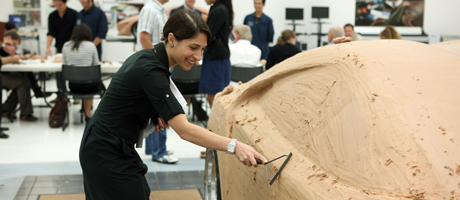By Menachem Wecker
Although she had not aspired to be a spokeswoman for an international automotive company growing up, Sona Iliffe-Moon had all the important parts in place.
A first generation American from a Lebanese Armenian family, Ms. Iliffe-Moon (née Sona Balanian) was born in Southern California but spent most of her childhood in Europe and Philadelphia.
“I was exposed to international affairs and a multitude of cultures from an early age,” says Ms. Iliffe-Moon, media relations manager of Toyota Motor Sales, U.S.A. “I always knew I’d live and study in Washington, D.C., which embodied my passion for international relations, public diplomacy, cultural studies and languages.”
GW’s urban campus appealed to the self-described “city girl to the core,” and Ms. Iliffe-Moon, B.A. ’02, has found that her studies in international affairs at the Elliott School, where she specialized in Russia and Eastern Europe, prepared her well for her career.
“There’s certainly a link between public diplomacy and public relations even if you drill down to the media relations function,” she says. “In diplomacy and media relations, the end goal is to persuade others to understand or agree with your position. Both practices have reputational impact.”
Diplomacy and PR also rely on third parties to spread their message, particularly with the proliferation of new media. “Practitioners of public diplomacy and public relations are both engaging the public in social media forums and need to belong to these communities to effectively practice communications,” says Ms. Iliffe-Moon, who writes the Twitter handles @SonaMoon and @Toyota and is an active LinkedIn user.
Toyota also prioritizes participating in communities that aren’t virtual. Although news reports about economic woes in the U.S. automotive industry tend to separate American and foreign companies, Ms. Iliffe-Moon, says her employer, though international, is “very local” in practice and invests heavily in the communities where it operates.
“Toyota has a substantial manufacturing and employment presence in the United States. More than half of the vehicles we sell in the United States are built here,” she says. “With 33,000 U.S. employees and more than $18 billion investment in the United States, you could say we are part of the fabric of the communities where we operate.”
Toyota is also committed to sustainability, according to Ms. Iliffe-Moon. “Toyota’s mission is to contribute to society, the economy and the environment by designing and building clean, safe and innovative vehicles,” she says. “In terms of reducing the environmental impact of mobility, we believe we must develop the right vehicle for the right place at the right time.”
The numbers speak for themselves. Toyota has sold more than 2 million hybrids globally, with more than half sold in the United States. Toyota and Lexus, which offer seven hybrids in the United States, more than any other automaker, account for 75 percent of U.S. hybrid sales, Ms. Iliffe-Moon says.
“We believe that conventional hybrids will proliferate over the short-, mid- and long-term, eventually being offered across our entire lineup,” she says. But Toyota’s commitment to hybrids is only part of the picture. The company is also researching and developing plug-in vehicles, electric cars, and fuel cell and compressed natural gas.
Ms. Iliffe-Moon credits her time in Washington with laying the foundation for her professional success. A fellow Elliott School student at GW helped her secure an opportunity to intern in the office of Rep. Steny Hoyer (D-Md.), now the House majority leader. Another Elliott School classmate alerted her to a fellowship at the State Department’s Bureau of Arms Control, which she was able to transition into a full-time job after graduation. She was one of the youngest to hold the position of foreign affairs officer at 21 years old.
“My current role in media relations at Toyota draws largely on lessons I learned during my studies at GW – conducting research and creating sound positions and arguments, strategizing and message development, issues management, and, most importantly, the art of diplomacy in all communications – both external and internal,” she says.
“My GW economics classes have also come in handy as it’s essential to understand the economy and its nuances in the automotive industry,” she adds. “My studies at GW really expanded my worldview and taught me about the consequences of words and communications. I carry this knowledge with me in all of my professional and personal endeavors.”


